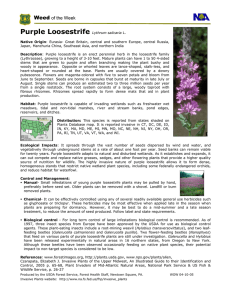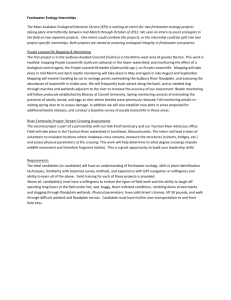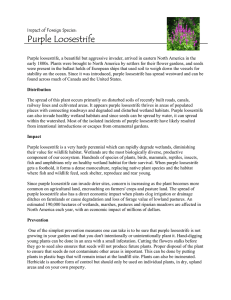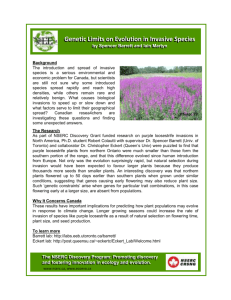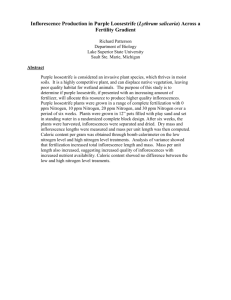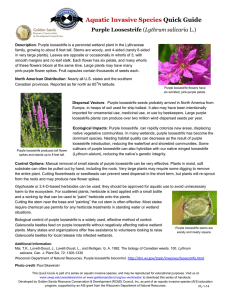Invasive Plants in Pennsylvania: Purple Loosestrife
advertisement
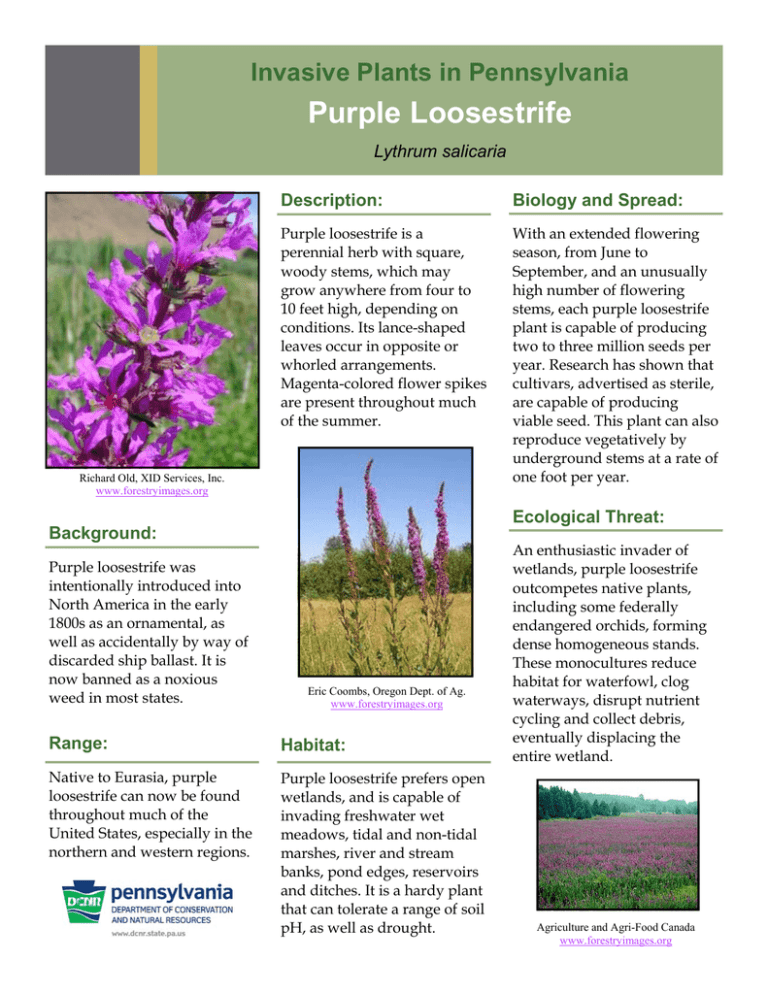
Invasive Plants in Pennsylvania Purple Loosestrife Lythrum salicaria Description: Biology and Spread: Purple loosestrife is a perennial herb with square, woody stems, which may grow anywhere from four to 10 feet high, depending on conditions. Its lance-shaped leaves occur in opposite or whorled arrangements. Magenta-colored flower spikes are present throughout much of the summer. With an extended flowering season, from June to September, and an unusually high number of flowering stems, each purple loosestrife plant is capable of producing two to three million seeds per year. Research has shown that cultivars, advertised as sterile, are capable of producing viable seed. This plant can also reproduce vegetatively by underground stems at a rate of one foot per year. Richard Old, XID Services, Inc. www.forestryimages.org Ecological Threat: Background: Purple loosestrife was intentionally introduced into North America in the early 1800s as an ornamental, as well as accidentally by way of discarded ship ballast. It is now banned as a noxious weed in most states. Eric Coombs, Oregon Dept. of Ag. www.forestryimages.org Range: Habitat: Native to Eurasia, purple loosestrife can now be found throughout much of the United States, especially in the northern and western regions. Purple loosestrife prefers open wetlands, and is capable of invading freshwater wet meadows, tidal and non-tidal marshes, river and stream banks, pond edges, reservoirs and ditches. It is a hardy plant that can tolerate a range of soil pH, as well as drought. An enthusiastic invader of wetlands, purple loosestrife outcompetes native plants, including some federally endangered orchids, forming dense homogeneous stands. These monocultures reduce habitat for waterfowl, clog waterways, disrupt nutrient cycling and collect debris, eventually displacing the entire wetland. Agriculture and Agri-Food Canada www.forestryimages.org How to Control this Species: Prevention Physical Chemical Early detection and prevention are the best approaches to managing purple loosestrife. Monitoring watersheds yearly to identify new infestations is critical, and can be most easily conducted in late July and August when the plant is in full bloom. Hand-pulling is only effective for seedlings with small roots. Glyphosate is effective against purple loosestrife. Be sure to use an herbicide permitted for wetland use. Herbicides can be applied directly to cut stems to reduce collateral damage. Clean seed and plant parts from animals, equipment and clothing before entering wetland areas. Mowing is not recommended, but may reduce the production of seeds. Flooding kills seedlings; established plants must be inundated for weeks. Unfortunately, this also kills desirable vegetation. The site may need to be replanted with native, competitive vegetation. Prevent nearby infestations from going to seed. Use native competitors as barriers. Biocontrol Although they will not eradicate purple loosestrife, biocontrols can reduce the severity of an infestation. Four species of beetles from Europe, which are fairly host-specific on purple loosestrife, are currently available for control efforts. Look-A-Likes: References: From a distance, purple loosestrife may resemble some native flowering plants, such as blazing star (Liatris sp.) and obedient plant (Physostegia virginiana). These also make great native garden alternatives. Center for Invasive Species and Ecosystem Health: http://www.invasive.org/browse/subinfo.cfm?sub=3047 Plant Conservation Alliance’s Alien Plant Working Group: http://www.nps.gov/plants/alien/fact/lysa1.htm University of Nevada Cooperative Extension: http://www.unce.unr.edu/publications/files/nr/2002/ For More Information: DCNR Invasive Species Site: http://www.dcnr.state.pa.us/ conservationscience/invasivespecies/index.htm Blazing Star John D. Byrd, Mississippi State University www.forestryimages.org DCNR Invasive Exotic Plant Tutorial for Natural Lands Managers: http://www.dcnr.state.pa.us/forestry/invasivetutorial/ Purple_loosestrife.htm
